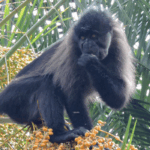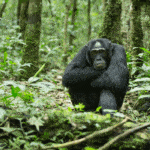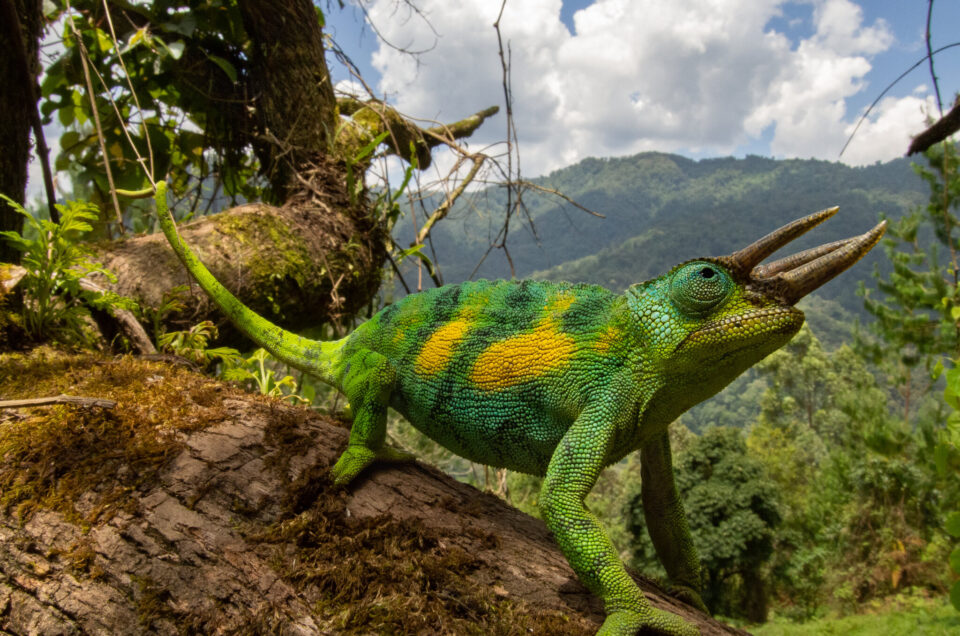The Exclusive three horned chameleons in Bwindi impenetrable forest, Mgahinga gorilla and in Rwenzori national parks in western Uganda. The three horned chameleons are endemic species that are found in the misty forests in western part of Uganda.
These exclusive three horned chameleon is endemic to the Albertine endemic region and can also be found at higher altitudes in Bwindi, Mgahinga, Uganda, Rwanda, and parts of the Democratic Republic of Congo.
A fully grown three-horned chameleon can reach a length of up to 30 centimeters, making them an impressive sight to behold.
Males are generally 10 to 12inches long with a long, prehensile tail accounting for half of their length, and with three horns protruding from their forehead. Females are generally a little shorter and never grow horns.
This is a hidden gem for nature enthusiasts. Within this park resides a rare and endangered species. These remarkable creatures make their home at altitudes ranging from 1700 meters to 2022 meters above sea level, where some lodges are located, making it the perfect destination for an exclusive three-horned chameleon tracking experience.
The color change you are seeing is based on structural changes of crystal like cells called iridophores underneath the skin that reflect light; Flynn says. When anything agitates or exhilarates the chameleon, things start to get interesting.
UV radiation has more energy than “visible” light detected by humans and can be dangerous in large doses. One of the most mysterious things about chameleons is their ability to see light in the ultraviolet spectrum. Presumably, their ultraviolet sense evolved to allow chameleons to better target their prey. It may also have something to do with the fact that chameleons become more active, social, and interested in breeding when exposed to UV rays, possibly because UV light stimulates the pineal glands in their tiny brains.
For many people, the most disquieting thing about chameleons is their eyes, which move independently in their sockets and thus provide a near-360-degree scope of vision. In addition to perceiving UV light, they’re great judges of distance, because each eye has excellent depth perception.
This allows the lizard to zero in on tasty prey insects from up to 20 feet away without binocular vision. Balancing its excellent sense of sight somewhat, chameleons have relatively primitive ears, and can only hear sounds in an extremely restricted range of frequencies.
The independently swerving eyes of a chameleon wouldn’t do much good if it couldn’t close the deal on prey. That’s why all chameleons are equipped with long, sticky tongues—often two or three times the length of their bodies—which they forcefully eject from their mouths.
Chameleons have two unique muscles to accomplish this task: the accelerator muscle, which launches the tongue at high speed, and the hypoglossal, which snaps it back with the prey attached to the end. Amazingly, a chameleon can launch its tongue at full force even in temperatures low enough to make other reptiles extremely sluggish.
Perhaps because of the extreme recoil caused by its ejecting tongue, chameleons need a way to stay firmly attached to the branches of trees. Nature’s solution is “zygodactylism” feet. A chameleon has two outer and three inner toes on its front feet, and two inner and three outer toes on its hind feet. Each toe features a sharp nail that digs into tree bark. Other animals—including perching birds and sloths—also evolved a similar anchoring strategy, though the five-toed anatomy of chameleons is unique.
While chameleons aren’t quite as adept at blending in with their surroundings as they’re depicted in cartoons—they cannot become invisible or transparent, nor can they mimic polka dots or plaid—these reptiles are still very talented. Most chameleons can change their color, and pattern, by manipulating the pigments and crystals of guanine (a type of amino acid) embedded in their skin.
This trick comes in handy for hiding from predators (or curious humans), but most chameleons change color to signal to other chameleons. For example, bright-colored chameleons are dominant in male-on-male contests, while more muted colors indicate defeat and submission.
These insectivores primarily feed on grasshoppers, butterflies, crickets, spiders, and various other insects. The biggest predators of three horned chameleon are birds, such as hornbills, and snakes.
Unfortunately, the habitat of these chameleons is under threat due to human activities like agriculture, resulting in a loss of their natural range.
While National parks can be visited year-round, the ideal months for a visit are during the dry seasons, which occur from June to August and from December to February. These months offer favorable conditions for trekking and exploring the park. For an exclusive three-horned chameleon tracking experience and more, contact Mirama Hills Safaris and embark on a memorable journey in the heart of Rwenzori forest, Bwindi Impenetrable forest and Mgahinga gorilla national parks.








